Book contents
- Frontmatter
- Contents
- Preface
- Acknowledgements
- Part I Planning
- Part II Habitats
- 4 Introduction to habitat evaluation
- 5 Habitat requirements and issues
- 6 Methods for surveying habitats
- 7 Surveying and monitoring management or environmental impacts
- 8 Habitat conservation evaluation criteria
- Part III Species
- Appendix 1 Monitoring and reporting obligations under international conservation agreements
- Appendix 2 Relationship between BAP Priority Habitat and Broad Habitat categories and Habitats Directive nomenclature
- Appendix 3 Annotated list of key references for plant identification
- Appendix 4 Determining appropriate quadrat size for vegetation sampling
- Appendix 5 The relocation of permanent plots
- Appendix 6 Equipment required for undertaking different types of survey
- Recommended sources of further information
- References
- Glossary
- Index
5 - Habitat requirements and issues
Published online by Cambridge University Press: 01 September 2010
- Frontmatter
- Contents
- Preface
- Acknowledgements
- Part I Planning
- Part II Habitats
- 4 Introduction to habitat evaluation
- 5 Habitat requirements and issues
- 6 Methods for surveying habitats
- 7 Surveying and monitoring management or environmental impacts
- 8 Habitat conservation evaluation criteria
- Part III Species
- Appendix 1 Monitoring and reporting obligations under international conservation agreements
- Appendix 2 Relationship between BAP Priority Habitat and Broad Habitat categories and Habitats Directive nomenclature
- Appendix 3 Annotated list of key references for plant identification
- Appendix 4 Determining appropriate quadrat size for vegetation sampling
- Appendix 5 The relocation of permanent plots
- Appendix 6 Equipment required for undertaking different types of survey
- Recommended sources of further information
- References
- Glossary
- Index
Summary
The primary purpose of this section is to identify, for each broad habitat type, the potential attributes that indicate the condition of the habitat and to recommend methods that may be used for monitoring each of these. These recommended methods are described individually in Chapter 6, or in Part III (species) for methods that are more often applicable to surveying and monitoring individual species. The section also identifies key management actions and other environmental factors that may have impacts on the habitat and may therefore require monitoring. Finally, any specific monitoring issues (e.g. practical implementation, health and safety and the frequency of monitoring) that may influence the design of a survey or monitoring programme in the habitat are briefly described. Habitats have been divided according to UK Biodiversity Action Plan (BAP) Broad Habitat types. Based on structural similarities the methods can be applied to the full range of habitat types found in Europe and, indeed, other parts of the world.
Within the UK, JNCC have recently published online guidelines on Common Standards Monitoring. This provides guidance on setting and assessing conservation objectives for the range of species and habitat features which occur on UK protected sites. The process is now well advanced, with guidance available on conservation objectives and assessment methodologies for about 75% of the features of designated sites. At the time of writing, guidance was available for coastal, lowland grassland, lowland heathland, upland and woodland habitat features. Guidance on lowland wetlands and freshwater habitats is being developed.
Information
- Type
- Chapter
- Information
- Handbook of Biodiversity MethodsSurvey, Evaluation and Monitoring, pp. 107 - 153Publisher: Cambridge University PressPrint publication year: 2005
Accessibility standard: Unknown
Why this information is here
This section outlines the accessibility features of this content - including support for screen readers, full keyboard navigation and high-contrast display options. This may not be relevant for you.Accessibility Information
- 1
- Cited by
